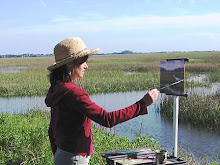I start out by using cardboard corner protectors on my framed paintings:
 Then I sandwich this configuration between two pieces of cardboard cut to size.
Then I sandwich this configuration between two pieces of cardboard cut to size.
I'll tape all of this together carefully, making sure only to tape cardboard to cardboard and not to tape any exposed frame! Then I will wrap this up in bubble wrap, much in the way I'd wrap a gift:
When boxing a painting, I make sure to have at least two inches of padding around all four edges of the painting, as well as front and back. Some people use peanuts, which are lightweight and great for filling, but I tend to steer away from that because they can be messy. Often times I will use foam sheets or bubble wrap for filling. My shipper, who I will sometimes use for larger framed paintings, once told me that when packing the piece in the box, you need to make sure that when closed, you cannot feel the painting moving in the box at all. Don't over stuff, but just make sure that there is no sloshing or shifting ability.
All of this gets boxed up in a heavy or double-ply cardboard shipping box. (My shipper will most often build sturdy boxes fit to size when I ship the large paintings.) Then I use strapping tape and clear wide shipping tape to seal. My shipper says I don't need the strapping tape if I'm using the shipping tape, but when I have it available I like to use it because it seems stronger to me. 
That's it! Now it's ready to go off to its new home.





